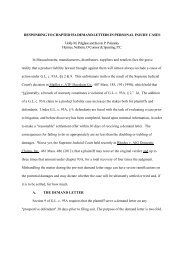From the Defense. Winning Closing Arguments Seminar - Hermes ...
From the Defense. Winning Closing Arguments Seminar - Hermes ...
From the Defense. Winning Closing Arguments Seminar - Hermes ...
You also want an ePaper? Increase the reach of your titles
YUMPU automatically turns print PDFs into web optimized ePapers that Google loves.
can, <strong>the</strong> same vocabulary you expect <strong>the</strong> judge to use. For example, if you learn that <strong>the</strong><br />
judge defines negligence in a certain manner, use that definition yourself. During <strong>the</strong> jury<br />
instructions, <strong>the</strong> more often you sound like <strong>the</strong> trial judge <strong>the</strong> better.<br />
Use Exhibits<br />
While jurors pay close attention to live testimony, if <strong>the</strong>y have something in <strong>the</strong>ir hands while<br />
deliberating it may be much more persuasive. If you have favorable exhibits, use <strong>the</strong>m<br />
during your closing. Photographs are particularly impressive. If you have good ones, take<br />
<strong>the</strong>m out of <strong>the</strong> power point, blow <strong>the</strong>m up, put <strong>the</strong>m on poster board and get <strong>the</strong>m into <strong>the</strong><br />
jury room. Medical records often also contain unexpected, but favorable items. You should<br />
review <strong>the</strong> medical records submitted by <strong>the</strong> plaintiff carefully. Sometimes, explanations as<br />
to how <strong>the</strong> accident happened, while arguably inadmissible, will actually be put into evidence<br />
by <strong>the</strong> plaintiff. Should that occur, you are free to comment about <strong>the</strong>m. It is sometimes<br />
effective to resist <strong>the</strong> temptation to present ei<strong>the</strong>r <strong>the</strong> plaintiff or ano<strong>the</strong>r witness with <strong>the</strong>se<br />
types of notations during cross-examination and, ra<strong>the</strong>r, simply to refer to <strong>the</strong>m during <strong>the</strong><br />
closing. For example, if <strong>the</strong> plaintiff has described <strong>the</strong> accident to an emergency room<br />
physician in a different way than he or she has testified, you can read that record to <strong>the</strong> jury<br />
and argue that <strong>the</strong> earlier version is more credible.<br />
Explain Agreements<br />
Many times you will enter into agreements with plaintiff’s counsel with respect to <strong>the</strong><br />
admissibility of certain evidence. This often occurs with medical bills and records. If you<br />
have agreed to <strong>the</strong> admissibility of those documents, you should explain to <strong>the</strong> jury exactly<br />
what <strong>the</strong> agreement was. Tell <strong>the</strong>m that in order to save <strong>the</strong>m time you conceded that <strong>the</strong><br />
doctors and o<strong>the</strong>r medical personnel would have testified to <strong>the</strong> fair and reasonable value of<br />
<strong>the</strong> medical services rendered. Emphasize, however, that you did not agree that <strong>the</strong><br />
defendant owes <strong>the</strong> plaintiff for those services.<br />
Explain Surveillance<br />
Jurors may be somewhat justifiably, at first blush, offended by your use of surveillance<br />
materials at trial. You must diffuse this offense by explaining that <strong>the</strong> plaintiff has sued your<br />
client, wants to be paid by your client and was untruthful to boot. Explain that <strong>the</strong><br />
surveillance was performed in public places only, and acknowledge that we all have certain<br />
privacy rights.



